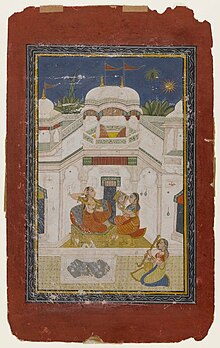
Back রাগ বিলাবল Bengali/Bangla ಬಿಲಾವಲ್ Kannada राग बिलावल Marathi राग बिलाबल NEW ਬਿਲਾਵਲ Punjabi බිලාවල් රාගය Singhalese
 | |
| Thaat | Bilaval |
|---|---|
| Type | Sampurna (7 by 7 ) |
| Arohana | Sa Re Ga ma, Ga Pa, Ni Dha Ni Sa' |
| Avarohana | Sa' Ni Dha, Pa, ma Ga, ma Re Sa |
| Pakad |
|
| Vadi | Dha |
| Samavadi | Ga |
| Synonym | Bilawal |
| Equivalent | |
| Hindustani classical music |
|---|
| Concepts |
| Genres |
| Thaats |
Bilaval or Bilawal (IAST: Bilāval) is a raga and the basis for the eponymous thaat (musical mode) in Hindustani classical music. Raga Bilaval is named after Veraval, Gujarat.[1]
Bilaval has been the standard for North Indian music since the early 19th century. Its tonal relationships are comparable to the Western music C major scale. Bilaval appears in the Ragamala as a ragini of Bhairav but today it is the head of the Bilaval thaat. The Ragamala names Bilaval as a Putra (son) of Bhairav but no relationship between these two ragas are made today. Bilaval is a morning raga that is intended to be sung with a feeling of deep devotion and repose and is often performed during the hot months.[citation needed] The Bilaval is equivalent to the Carnatic raga melakarta, Sankarabharanam, as well as the Western Ionian mode (major scale), and contains the notes S R G M P D N S'. The pitches of Bilaval thaat are all shuddha (natural). Flat (komal) or sharp (tivra) pitches always occur regarding the interval pattern in Bilaval thaat.
Bilaval raga is in the Sikh tradition of northern India and is part of the Sikh holy scripture Granth, the Sri Guru Granth Sahib.[2] Every raga has a set of strict rules that govern the number of notes that can be used, which notes can be used, and their interplay that must be adhered to for the composition of a tune. Bilaval is the thirty-fourth raga to appear in the series of sixty compositions in the Sri Guru Granth Sahib. The composition in this raga appears on 64 pages from page numbers 795 to 859.
- ^ Delvoye, Françoise (2013). New Developments in Asian Studies. Routledge. p. 344. ISBN 978-1-136-17470-4. Archived from the original on 26 May 2021. Retrieved 11 March 2018.
- ^ Singha, H.S. (2000). The Encyclopedia of Sikhism (over 1000 Entries). Hemkunt Publishers. p. 10. ISBN 978-81-7010-301-1. Retrieved 26 May 2021.